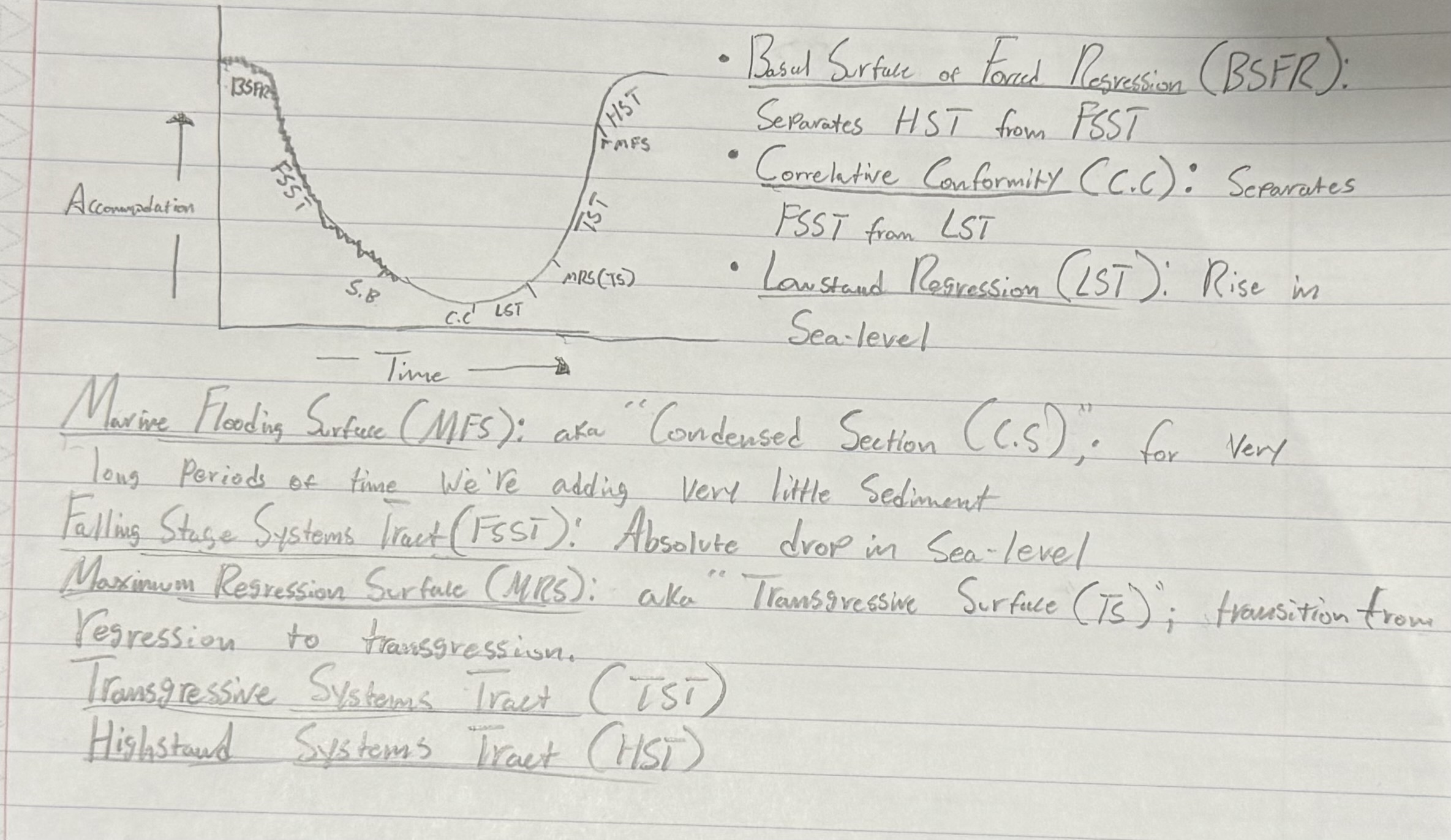Sequence Stratigraphy
1/13
There's no tags or description
Looks like no tags are added yet.
Name | Mastery | Learn | Test | Matching | Spaced |
|---|
No study sessions yet.
14 Terms
Sequence Stratigraphy > Lithostratigraphy
Lithostratigraphy: deals with lithology of strata and their organization into units based on lithological characteristics
Sequence Stratigraphy: considers depositional environments, systems tracts, and relative sea-level changes, offering a comprehensive framework for understanding the lateral and vertical variability of sedimentary packages.
Reconstructing depositional systems, predicting subsurface reservoirs, and linking stratigraphy to tectonic and climatic influences
Sedimentary Accommodation vs. Water Depth
Accommodation: Amount of available space for sediment to fill in a basin, from seafloor to base-level
Water Depth: Vertical distance from water surface to the ocean/lake floor at a given point
Accommodation is a measure of potential sediment storage space, whereas water depth is a direct measurement of current water levels
Walther’s Law
The same succession that is present vertically also is present horizontally unless there is a break in sedimentation (Posamentier and Allen, 1999)
Forced Regression vs. Normal Regression
Forced Regression: Shoreline migrates seaward due to a drop in base-level, regardless of sediment supply
Normal Regression: Seaward migration of a shoreline due to the oversupply of sediment
Systems Tract w/ well-developed, mature Paleosols
Falling Stage Systems Tract
Valleys creep updip and expand laterally, allowing for best paleosols
Sequence
A relatively conformable succession of genetically related strata bounded by unconformities or their correlative conformities.
Parasequence
Stratigraphic unit used to describe a relatively conformable succession of genetically related beds and/or bedsets bounded by flooding surfaces and may coincide with other systems tract boundaries.
What problems does the author have with the parasequence concept?
Main problem → Flooding surfaces
Flooding surfaces are poorly defined term that allows for multiple meanings
Depending on what type of stratigraphic surface the flooding surface actually is, parasequences may be anything from transgressive-regressive sequences to genetic stratigraphic sequences and allostratigraphic units.
When does the author suggest that the term parasequence may be used?
Restricted to prograding successions in coastal to shallow-water settings, where evidence of flooding surfaces can be produced
And where transgressive ravinement surfaces (erosional surfaces) are unlikely to occur
Systems Tracts
A linkage of contemporaneous depositional systems, forming the subdivision of a sequence, and depositing at a deepening or swallowing rate
Depositional Sequence
Three-dimensional assemblages of lithofacies, genetically linked by active processes of inferred processes and environments. Sediments are distributed and accumulated within a specific bathometric or climate
Systems Tracts and Sequence Stratigraphic Succession
Basal Surface of Forced Regression (BSFR): Separates HST from FSST
Falling Stage Systems Tract (FSST): Absolute drop in sea-level; Forced Regression
Sequence Boundary (SB)
Correlative Conformity (C.C): Separates FSST from LST
Lowstand Systems Tract (LST): Regression; rise in sea-level
Maximum Regression Surface (MRS): aka “Transgressive Surface (TS);” transition from regression to transgression
Transgressive Systems Tract (TST)
Maximum Flooding Surface (MFS): aka “Condensed Section (C.S);” for very long periods of time we’re adding very little sediment
Highstand Systems Tract (HST)

Can a Transgressive and a Regressive Systems Tracts be located on the same shoreline?
Yes, they represent different stages of sea level change and shoreline movement within a single depositional sequence. Can be expressed in Transgressive-Regressive Sequence (T-R). A T-R sequence can be divided into a transgressive systems tract below and a regressive systems tract above by using the maximum flooding surface (MFS) as a mutual boundary.